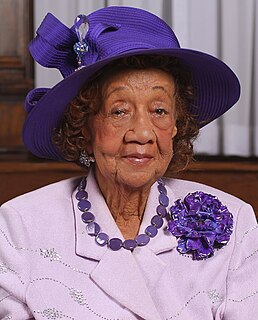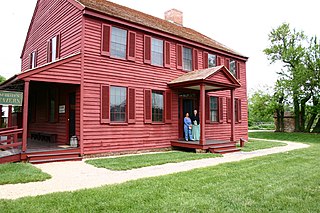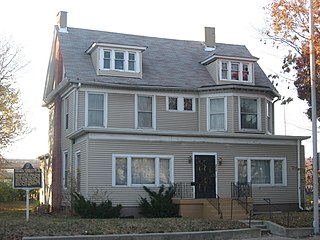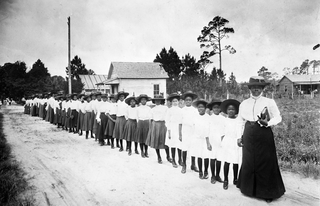
Logan Circle is a traffic circle park, neighborhood, and historic district in the Northwest quadrant of Washington, D.C. The primarily residential neighborhood includes two historic districts, properties listed on the National Register of Historic Places, and sites designated D.C. Historic Landmarks. Vermont Avenue NW, Rhode Island Avenue NW, 13th Street NW, and P Street NW meet at the circle. An equestrian statue of Major General John A. Logan stands at its center. It is the only major circle downtown that remains entirely residential.

Dorothy Irene Height was an African American civil rights and women's rights activist. She focused on the issues of African American women, including unemployment, illiteracy, and voter awareness. Height is credited as the first leader in the civil rights movement to recognize inequality for women and African Americans as problems that should be considered as a whole. She was the president of the National Council of Negro Women for 40 years.

The National Council of Negro Women (NCNW) is a nonprofit organization founded in 1935 with the mission to advance the opportunities and the quality of life for African-American women, their families, and communities. Mary McLeod Bethune, the founder of NCNW, wanted to encourage the participation of Negro women in civic, political, economic and educational activities and institutions. The organization was considered as a cleaning house for the dissemination of activities concerning women but wanted to work alongside a group who supported civil rights rather than go to actual protests. Women on the council fought more towards political and economic successes of black women to uplift them in society. NCNW fulfills this mission through research, advocacy, national and community-based services and programs in the United States and Africa.

Mary Jane McLeod Bethune was an American educator, philanthropist, humanitarian, womanist, and civil rights activist. Bethune founded the National Council of Negro Women in 1935, established the organization's flagship journal Aframerican Women's Journal, and presided as president or leader for myriad African American women's organizations including the National Association for Colored Women and the National Youth Administration's Negro Division. She also was appointed as a national adviser to president Franklin D. Roosevelt, whom she worked with to create the Federal Council on colored Affairs, also known as the Black Cabinet. She is well known for starting a private school for African-American students in Daytona Beach, Florida. It later continued to develop as Bethune-Cookman University. Bethune was the sole African American woman officially a part of the US delegation that created the United Nations charter, and she held a leadership position for the American Women's Voluntary Services founded by Alice Throckmorton McLean. For her lifetime of activism, she was deemed "acknowledged First Lady of Negro America" by Ebony magazine in July 1949 and was known by the Black Press as the "Female Booker T. Washington". She was known as "The First Lady of The Struggle" because of her commitment to gain better lives for African Americans.
National Capital Parks-East (NACE) is an administrative grouping of multiple National Park Service sites east of the United States Capitol in Washington, D.C., and in the state of Maryland. These sites include:

Carter G. Woodson Home National Historic Site at 1538 9th Street NW, in the Shaw neighborhood of Washington, D.C., preserves the home of Carter G. Woodson (1875–1950). Woodson, the founder of Black History Month, was an African-American historian, author, and journalist.

The Mary McLeod Bethune Home is a historic house on the campus of Bethune-Cookman University in Daytona Beach, Florida. Built in the early-1900s, it was home to Mary McLeod Bethune (1875-1955), a prominent African-American educator and civil rights leader, from 1913 until her death. It was designated a United States National Historic Landmark in 1974 It is now managed by the Mary McLeod Bethune Foundation as a historic house museum.

Arenia Conelia Mallory was an American educator based in Lexington, Mississippi. She was recognized nationally as a political activist working for African-American education and civil rights. She gained a national reputation as president of Saints Industrial and Literary School, which she developed over 50 years from a few students in 1926 to a private K-12 academic school and junior college on 350 acres. It was affiliated with the Pentecostal Church of God in Christ, in which Mallory had been active since about age 18.

The Belmont–Paul Women's Equality National Monument is a historic house and museum of the U.S. women's suffrage and equal rights movements located in the Capitol Hill neighborhood of Washington, D.C. The monument is named after suffragists and National Woman's Party leaders Alva Belmont and Alice Paul.

The Surratt House is a historic house and house museum located at 9110 Brandywine Road in Clinton, Prince George's County, Maryland, United States. The house is named for John and Mary Surratt, who built it in 1852. Mary Surratt was hanged in 1865 for being a co-conspirator in the Abraham Lincoln assassination. It was acquired by the Maryland-National Capital Park and Planning Commission (M-NCPPC) in 1965, restored, and opened to the public as a museum in 1976.
The National Park System preserves and interprets the history of women in American society. Many national parks, monuments and historic sites represent America's women's history as a primary theme, while numerous others address American women's history somewhere in their programs and preservation activities. The lists of sites below is not exhaustive, but includes sites closely related to themes in U.S. Women's History. Click here for an article on Women in the National Park Service.

Mary McLeod Bethune Memorial is a bronze statue honoring educator and activist Mary McLeod Bethune, by Robert Berks.
Bettye Collier-Thomas is a scholar of African-American women's history.

Indiana State Federation of Colored Women's Clubs, also known as the Minor House, is a historic National Association of Colored Women's Clubs clubhouse in Indianapolis, Indiana. The two-and-one-half-story "T"-plan building was originally constructed in 1897 as a private dwelling for John and Sarah Minor; however, since 1927 it has served as the headquarters of the Indiana State Federation of Colored Women's Clubs, a nonprofit group of African American women. The Indiana federation was formally organized on April 27, 1904, in Indianapolis and incorporated in 1927. The group's Colonial Revival style frame building sits on a brick foundation and has a gable roof with hipped dormers. It was listed on the National Register of Historic Places in 1987.
National Archives for Black Women's History is an archive located at 3300 Hubbard Rd, Landover, Maryland. It is dedicated to cataloguing, restoring and preserving the documents and photographs of African American women. The collection work began in 1935 and was formalized into the National Archives for Black Women's History in 1978. Originally housed at 1318 Vermont Avenue, Washington, D.C. in the carriage house of the former home of Mary McLeod Bethune, which is now a National Historic Site, the archive was controversially moved in 2014 by the National Park Service citing concerns over the inadequacy of the original site for preservation of its collection.

Violet Mae Lopez Watson was a Jamaican-born American clubwoman and community leader. She was a co-founder with Mary McLeod Bethune of the National Council of Negro Women.

Ida E. Jones is an American historian and author who is the University Archivist at Morgan State University, the first archivist in the university's history.

Daytona Normal and industrial School, originally Daytona Educational and Industrial Training School for Negro Girls was established in Daytona Beach, Florida by Mary McLeod Bethune in 1904. Bethune was active in voter registration and campaigning for women's suffrage. Her school was reportedly threatened by the Ku Klux Klan and she stood vigil to protect it.

















